Railway stations: India
This is a collection of articles archived for the excellence of their content. |
Contents |
Cleanest railway stations
The Times of India, Mar 18 2016
Mahendra Singh
Surat, Rajkot cleanest rly stations, Pune dirtiest
Surat, Rajkot and Bilaspur are among the cleanest train stations in the country, followed by Solapur, Mumbai Central and Chandigarh, according to a preliminary survey commissioned by the Railways. The stations at Bhubanes war and Vadodara are next in the cleanliness ladder among the 75 A1-category stations which were surveyed.
Pune has the dirtiest station, followed by Mughalsarai, Guwahati, Nizamuddin (Delhi), Sealdah and Kanpur Central. Others found at the bottom of the ladder are Bho pal, Muzaffarpur, Thrisur, Raipur, Varanasi and Delhi.
Among the top 10 cleanest stations in `A' category (332 stations) are Beas (Punjab), Jamnagar, Gandhidham and Vasco-Da-Gama (Goa).
Shahganj, Ballia and Janghai (Uttar Pradesh), Madhubani and Bakhtiyarpur (Bihar) and Raichur (Karnataka) are among the 10 least clean stations.
All 75 A-1and 332 A category stations across 16 zonal railways were surveyed based on passenger perception on cleanliness at the stations.
Releasing the preliminary report, railway minister Suresh Prabhu said, “The idea is to make the entire rail network clean. This is just the beginning of a process which will actually and eventually bring all stations on par with a particular standard.“
Prabhu said the move is aimed at improving cleanliness at 8,000 stations across the country and take forward the `Swachh Rail, Swachh Bharat' mission.
2018
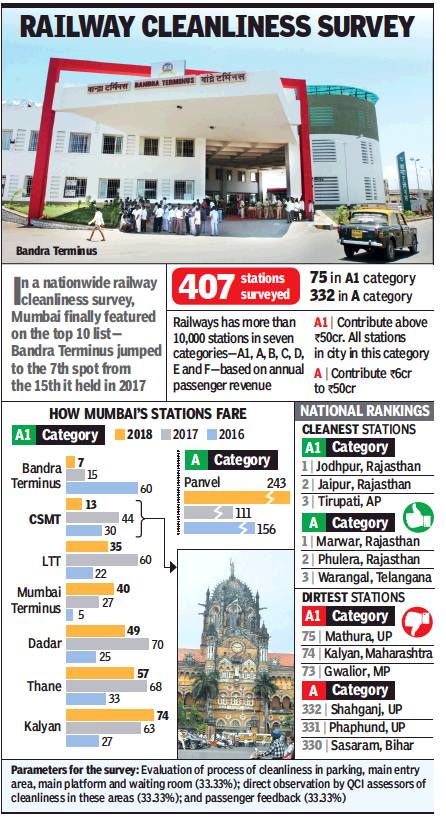
From: MANTHANK MEHTA, August 14, 2018: The Times of India
See graphic:
The cleanest (and dirtiest) railway stations of India, 2018
Delhi’s railway stations
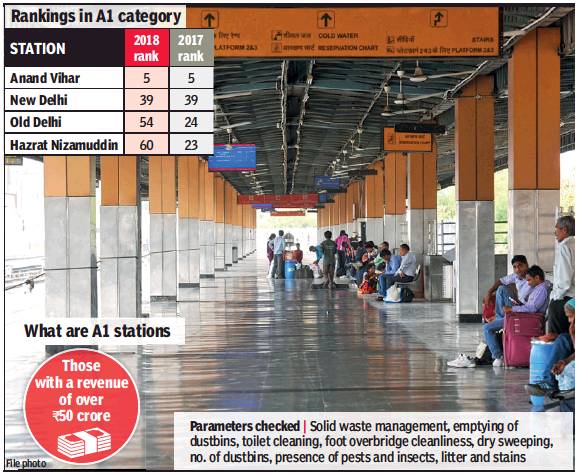
From: Jasjeev Gandhiok, Anand Vihar Delhi’s cleanest railway station, fifth in India, August 14, 2018: The Times of India
SWACHH RANKING: Old Delhi, Nizamuddin Record Sharp Falls
For a second successive year, Delhi’s Anand Vihar railway station has been ranked as the fifth cleanest station by the latest Swachh Railway report released on Monday. The station is the highest ranked among all railway stations in the capital, with the next best being the New Delhi railway station at a rank of 39, followed by Old Delhi (54) and Hazrat Nizamuddin (60) stations.
While both Anand Vihar and New Delhi railway stations matched their ranks from last year, both Old Delhi and Hazrat Nizamuddin stations recorded sharp decline, and fell 30 and 37 places respectively. Last year, Hazrat Nizamuddin was the second best Delhi station with a ranking of 23, while Old Delhi was ranked 24.
Railway officials said that Anand Vihar’s structural designs and practical features have helped it maintain a high rank. The station also makes use of subways instead of foot overbridges, which help reduce congestion on the platforms, said officials. “The loading of food and other parcel items takes place in the stabling area rather than near the platform to ensure no waste is generated. Exit rooms at the station also don’t open towards the platform but towards the entry/exit zone, which keeps the platforms clean,” said a senior railway official.
A1 category stations are all stations that generate a revenue of more than Rs 50 crores. Talking about the drop in rankings for both Old Delhi and Hazrat Nizamuddin, railway officials say it could be due to the ongoing construction work taking place.
“We are revamping all the major stations and a lot of debris is being generated that may make the station look unclean. We are working on improving these stations on a number of parameters and we expect better results next year,” said R N Singh, DRM, Delhi division.
Among the smaller stations that fell in the A category (revenue between Rs 6-50 crores), Delhi fared similarly with Delhi Cantt, Shahdara, Sarai Rohilla and Adarsh Nagar stations, all recording a drop in rankings. Sarai Rohilla station fell to rank 230 in 2018 compared to 122 in 2017. Similarly, Shahdara has been ranked 300 in the A category – a drop from 230, Delhi Cantt 315 – a drop from 86 last year and Adarsh Nagar has been ranked 326 – a drop from 285 in 2017.
2019
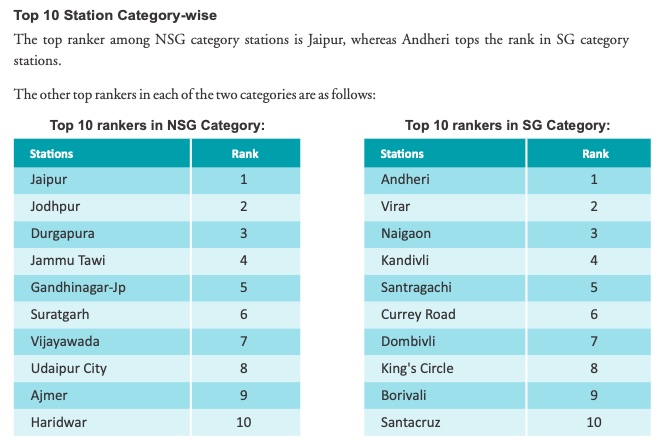
From: Press Information Bureau

From: Press Information Bureau
Rajasthan tops
Oct 3, 2019: The Times of India
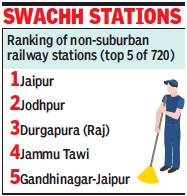
From: Oct 3, 2019: The Times of India
Seven railway stations in Rajasthan, including three from the capital region of Jaipur, bagged the top 10 places in a railway cleanliness survey which was released. The three stations in the state capital are Jaipur (No. 1), Durgapura and Gandhinagar-Jaipur. The other four are Jodhpur (2), Suratgarh (6), Udaipur (8) and Ajmer (9).
Among 109 suburban stations, Andheri, Virar and Naigaon stations in Maharashtra were found to be the cleanest, says the report released by minister Piyush Goyal. Anand Vihar, adjudged to be Delhi’s cleanest station, ranked 26th.
Green cover at stations also mattered
A total of 720 stations were ranked based on different parameters, and the process also involved taking feedback from passengers and direct observation by third-party assessors. Suburban stations were included for the first time in this survey and even green cover at stations was considered while ranking them. The report named North Western Railway as the cleanest railway zone, followed by South East Central Railway and East Central Railway.
Releasing the report, Goyal said cleanliness at stations and in trains has improved dramatically in the past five years while claiming that there has been a significant transformation from “suffer” to “safar”.
Delhi’s best
Oct 3, 2019: The Times of India

From: Oct 3, 2019: The Times of India
Railway stations in Delhi aren’t the cleanest in India, with Anand Vihar the best in the city but only ranked 26th across the country. According to the cleanliness rankings released by Union railway minister Piyush Goyal, the top three non-suburban stations in this regard are all in Rajasthan — Jaipur, Jodhpur and Durgapura. Among the 109 suburban stations assessed, Andheri, Virar and Naigaon occupied the top spots.
While Anand Vihar was at number 26 in the list of 611nonsuburban stations, New Delhi railway station was ranked 165, followed by Hazrat Nizamuddin at 241. Other city stations were further down the list — Shahdara at 378, Delhi Cantt at 389, Delhi Junction at 390 and Sarai Rohilla at 474. The Sadar Bazar station had the ignominy of being the second worst among the stations.
S C Jain, divisional railway manager, Delhi Division, countered that the survey did not differentiate between large and small stations, the latter being easier to maintain. “New Delhi has seen tremendous improvements in the past few years, but over five lakh passengers use it each day. A comparably smaller station with fewer platforms will be easier to maintain,” Jain explained.
He said upgradation work was in progress in the city’s major stations. “At the time the survey was carried out, a lot of work was going on. Even today, you will find debris at Old Delhi, New Delhi and Hazrat Nizamuddin stations,” said Jain. “We intend to revamp several areas and once this is over, the improvements will lead to better rankings.”
A total of 720 railway stations were analysed this year on various parameters through a third party audit, which included observations on the ground, feedback of passengers and green ratings awarded to the stations. The parking areas, platforms, toilets, waiting spaces, entry of the station and counter locations were evaluated. “In addition to observing cleaning frequency in these areas, the evaluation also involved the assessors observing the condition of the uniform, protective gear and equipment used by the cleaning staff,” said the ranks report.
Passengers were queried about their views on cleanliness in the most common consumer interface areas with the metrics including litter, stagnant water and presence of vermin. “They were then asked to rate their overall experience based on the cleanliness and upkeep of stations,” the survey report said.
While Indian Railways had been auditing 407 stations since 2016, this year, the assessment was expanded to 720 stations, including a separate category of 109 suburban stations. North Western Railway, which covers a route length of more than 5,761 km across parts of Rajasthan, Gujarat, Punjab and Haryana, topped the list among zones, followed by South East Central Railway and East Central Railway.
Smart Railway stations
Delhi



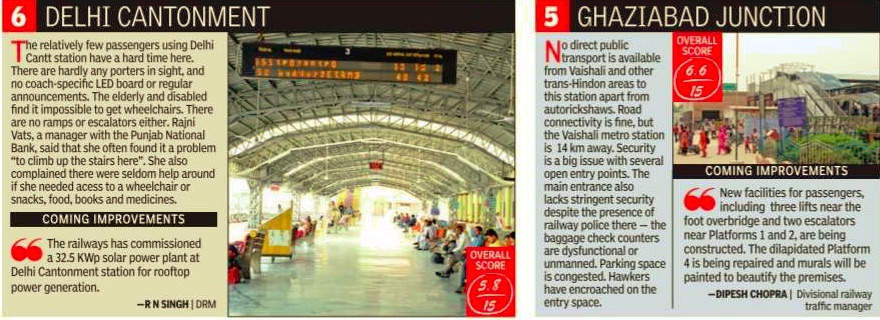
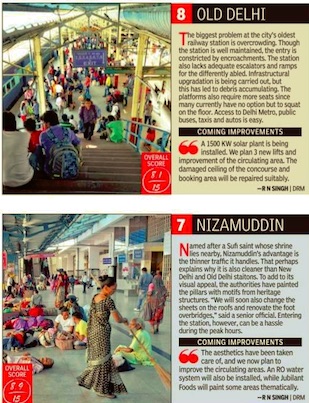
See pictures:
How smart are railway stations in Delhi
New Delhi and Anand Vihar railway stations in Delhi
Sarai Rohilla and Gurgaon railway stations in Delhi
Delhi cantonment and Ghaziabad railway stations in Delhi
Renaming a station
A backgrounder
Avishek G Dastidar, Nov 16, 2021: The Indian Express
Changing of railway station names is not new. There are times when state governments decide to go for a name change to represent long-standing popular demand or history, or as part of a political project pushing for a wider iconography. For instance, in 1996, the city of Madras was officially rechristened ‘Chennai’ to underline history and local sentiments. The name of the railway station, too, changed from Madras to Chennai as a result.
Since 2014, a number of stations have got new names. The most notable among them was Mughalsarai Junction, which became Pandit Deen Dayal Upadhyay Junction in 2018 to honour the right-wing ideologue who was found dead in Mughalsarai in 1968.
In the same year, Allahabad was renamed Prayagraj by the Yogi Adiyanath government. Of late, the Manduadih station in Varanasi in Uttar Pradesh was renamed Benaras to reflect the name by which the city is known. The larger station representing the city is already called Varanasi Junction.
Again this year, on Diwali, the Faizabad Junction station next to Ayodhya was renamed Ayodhya Cantonment station.
How are railway station names changed?
It is a common misconception that Indian Railways can change the name of its stations. That is not the case. While Indian Railways may own the station, it does not get involved in the business of naming it. This is left to the discretion of the state government concerned. Change of station names is entirely a state subject even though Railways belong to the Union government.
The state governments send the request to the Ministry of Home Affairs, the nodal ministry for these matters, which then accords its approval, keeping the Ministry of Railways in the loop. Usually, it is ensured that no other station with the new name proposed exists anywhere in India. If a state government wants to change the name of a city, generally, there is little reason for the Centre to come in the way or keep an old name in circulation, including in the signage of its properties there.
Indian Railways receives regular representations from civil society groups, political parties and others to change the names of stations, citing historical reasons or local sentiments. In most cases, it replies that it is a matter for the state government and the Home ministry.
What happens when a name is changed?
Once the name change is notified by the state government following all due process, Indian Railways steps in to do the necessary work. A new station “code” for railway operation purposes may need to be invented. For instance Faizabad Junction’s code used to be “FD” but post the name change, the new code is “AYC”. The name change is then fed into its ticketing system so that the new name along with the code is reflected on its tickets and reservation and train information.
Lastly, it physically changes the name written at the station — building, platform signage, etc, and also in its communication materials for all practical purposes.
How are the languages, spellings to be displayed on the signboard decided?
This aspect is governed by what is known as the Indian Railway Works Manual— a 260-odd-page document that codifies everything related to civil engineering construction works. Traditionally, station names were written only in Hindi and English. Over time, it was instructed that a third language, which is the local language, should be included.
Even then, the matter is not simple. Paragraph 424 of the Manual says that Railways should obtain approval of the state government concerned on the spelling of the names (in all three languages) before putting them on its signboards.
“The station names shall be exhibited in the following order: Regional Language, Hindi and English, except for Tamil Nadu where the use of Hindi will be restricted to important stations and pilgrim centres as determined by the Commercial Department. Where the Regional language is Hindi, the name boards will be in two languages, Hindi and English…,” the Manual says.